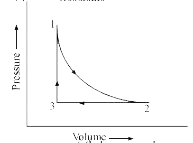Which quantity out of ΔrG or ΔrG∘ will be zero at equilibrium?
ΔrG=ΔrG∘+RTlnK. When reaction attains equilibrium ΔrG=0 so thatΔrG∘=−RT ln K . Thus ΔrG∘=0 only when K+1 . For all other values of K,ΔrG∘ will be non-zero.
Topper's Solved these Questions
- BOOK - PRADEEPCHAPTER - THERMODYNAMICSEXERCISE - MATCHING TYPE QUESTIONS8videos
THERMODYNAMICS
- BOOK - PRADEEPCHAPTER - THERMODYNAMICSEXERCISE - ASSERTION AND REACTION TYPES QUESTIONS3videos
THERMODYNAMICS
- BOOK - PRADEEPCHAPTER - THERMODYNAMICSEXERCISE - NCERT EXEMPLAR PROBLEMS WITH ANSWERS, HINTS AND SOLUTIONS( MULTIPLE CHOICE QUESTIONS-II)5videos
THERMODYNAMICS
- BOOK - PRADEEPCHAPTER - STRUCTURE OF ATOMEXERCISE - Competition Focus (JEE (Main and Advanced)/Medical Entrance (IX. Assertion And Reason Type Questions (Type II))12videos
STRUCTURE OF ATOM
Similar Questions
Which quantity out of ΔrG or ΔrG∘ will be zero at equilibrium?
View Solution(a) A sample of 1.0 mol of a monoatomic ideal gas is taken through a cyclic process of expansion and compression as shown in figure. What will be the value of ΔH for the cycle as a whole?
(b) Which quantity out of ΔrG and ΔrGΘ will be zero at equilibrium?
 View Solution
View Solution
Knowledge Check
- Question 1 - Select One
Standard Gibb's energy of reaction (ΔrG∘) at a certain temperature can be computed as ΔrG∘=ΔrH∘−T.ΔrS∘ and the change in the value of ΔrH∘ and ΔrS∘ for a reaction with temperature can be computed as follows
ΔrH∘T2−ΔrH∘T1=ΔrC∘p(T2−T1)
ΔrS∘T2−ΔrS∘T1=ΔrC∘pln(T2T1)
ΔrG∘=ΔrH∘−T.ΔrS∘
and by ΔrG∘=−RTlnKeq
Consider the following reaction :
CO(g)+2H2(g)⊂CH3OH(g)
Given : ΔfH∘(CH3OH),g=−201kJ/mol
ΔfH∘(CO,g)=−114kJ/mol
S∘(CH3OH,g)=240J/K−mol,S∘(H2,g)=29JK−1mol−1
S∘(CO,g)=198J/mol−K,C∘p,m(H2)=28.8J/mol−K
C∘p,m(CO)=29.4J/mol−K,C∘p,m(CH3OH)=44J/mol−K
and ln(320300)0.06, all data at 300 K
ΔrG∘ at 320 K isA−48295.2kJ/molB−240.85kJ/molC240.85kJ/molD−81.91kJ/mol - Question 2 - Select One
Standard Gibb's energy of reaction (ΔrG∘) at a certain temperature can be computed as ΔrG∘=ΔrH∘−T.ΔrS∘ and the change in the value of ΔrH∘ and ΔrS∘ for a reaction with temperature can be computed as follows
ΔrH∘T2−ΔrH∘T1=ΔrC∘p(T2−T1)
ΔrS∘T2−ΔrS∘T1=ΔrC∘pln(T2T1)
ΔrG∘=ΔrH∘−T.ΔrS∘
and by ΔrG∘=−RTlnKeq
Consider the following reaction :
CO(g)+2H2(g)⊂CH3OH(g)
Given : ΔfH∘(CH3OH),g=−201kJ/mol
ΔfH∘(CO,g)=−114kJ/mol
S∘(CH3OH,g)=240J/K−mol,S∘(H2,g)=29JK−1mol−1
S∘(CO,g)=198J/mol−K,C∘p,m(H2)=28.8J/mol−K
C∘p,m(CO)=29.4J/mol−K,C∘p,m(CH3OH)=44J/mol−K
and ln(320300)0.06, all data at 300 K
ΔrH∘ at 300 K for the reaction isA−87kJ/molB87kJ/molC−315kJ/molD−288kJ/mol - Question 3 - Select One
Standard Gibb's energy of reaction (ΔrG∘) at a certain temperature can be computed as ΔrG∘=ΔrH∘−T.ΔrS∘ and the change in the value of ΔrH∘ and ΔrS∘ for a reaction with temperature can be computed as follows
ΔrH∘T2−ΔrH∘T1=ΔrC∘p(T2−T1)
ΔrS∘T2−ΔrS∘T1=ΔrC∘pln(T2T1)
ΔrG∘=ΔrH∘−T.ΔrS∘
and by ΔrG∘=−RTlnKeq
Consider the following reaction :
CO(g)+2H2(g)⊂CH3OH(g)
Given : ΔfH∘(CH3OH),g=−201kJ/mol
ΔfH∘(CO,g)=−114kJ/mol
S∘(CH3OH,g)=240J/K−mol,S∘(H2,g)=29JK−1mol−1
S∘(CO,g)=198J/mol−K,C∘p,m(H2)=28.8J/mol−K
C∘p,m(CO)=29.4J/mol−K,C∘p,m(CH3OH)=44J/mol−K
and ln(320300)0.06, all data at 300 K
ΔrS∘ at 320 K isA155.18 J/mol - KB150.02 J/mol - KC172 J/mol - KDNone of these
Which quantity out of ΔrG or ΔrG∘ will be zero at equilibrium?
View SolutionCan E∘cell or ΔrG∘ for cell reaction ever be equal to zero?
View SolutionStandard Gibb's energy of reaction (ΔrG∘) at a certain temperature can be computed as ΔrG∘=ΔrH∘−T.ΔrS∘ and the change in the value of ΔrH∘ and ΔrS∘ for a reaction with temperature can be computed as follows
ΔrH∘T2−ΔrH∘T1=ΔrC∘p(T2−T1)
ΔrS∘T2−ΔrS∘T1=ΔrC∘pln(T2T1)
ΔrG∘=ΔrH∘−T.ΔrS∘
and by ΔrG∘=−RTlnKeq
Consider the following reaction :
CO(g)+2H2(g)⊂CH3OH(g)
Given : ΔfH∘(CH3OH),g=−201kJ/mol
ΔfH∘(CO,g)=−114kJ/mol
S∘(CH3OH,g)=240J/K−mol,S∘(H2,g)=29JK−1mol−1
S∘(CO,g)=198J/mol−K,C∘p,m(H2)=28.8J/mol−K
C∘p,m(CO)=29.4J/mol−K,C∘p,m(CH3OH)=44J/mol−K
and ln(320300)0.06, all data at 300 K
ΔrH∘ at 320 K isView SolutionStandard Gibb's energy of reaction (ΔrG∘) at a certain temperature can be computed as ΔrG∘=ΔrH∘−T.ΔrS∘ and the change in the value of ΔrH∘ and ΔrS∘ for a reaction with temperature can be computed as follows
ΔrH∘T2−ΔrH∘T1=ΔrC∘p(T2−T1)
ΔrS∘T2−ΔrS∘T1=ΔrC∘pln(T2T1)
ΔrG∘=ΔrH∘−T.ΔrS∘
and by ΔrG∘=−RTlnKeq
Consider the following reaction :
CO(g)+2H2(g)⊂CH3OH(g)
Given : ΔfH∘(CH3OH),g=−201kJ/mol
ΔfH∘(CO,g)=−114kJ/mol
S∘(CH3OH,g)=240J/K−mol,S∘(H2,g)=29JK−1mol−1
S∘(CO,g)=198J/mol−K,C∘p,m(H2)=28.8J/mol−K
C∘p,m(CO)=29.4J/mol−K,C∘p,m(CH3OH)=44J/mol−K
and ln(320300)0.06, all data at 300 K
ΔrS∘ at 300 K for the reaction isView SolutionStandard Gibbs energy of reaction (ΔrG∘) at a certain temperature can be completed as ΔrG∘=ΔrH∘−TδrS∘ and the change in the value of ΔrH∘ and ΔrS∘ for a reaction with temperature can be computed as follows:
ΔrH∘T2−ΔrC∘p(T2−T1)
ΔrS∘T2−ΔrS∘T1=ΔrC∘pIn(T2T2)
ΔrG∘=ΔrH∘−T.ΔrS∘
Δ∘rG∘=−RTInKeq
Consider the following reaction :
CO(g)+2H2(g)→CH3OH(g)
Given
ΔrH∘(CH3Oh,g]=−201KJ/mol
ΔrH∘(CO,g)=−114KJ/mol
s∘(CH3OH,g)=240J/mol−k,
S∘(H2g)=198J/mol−K
C∘p.m(h2)=28.8JK−1mol−1
Cp.m(CO)=29.4J/mol−K
C∘p.m(CH3□OH)=44J/mol−K
andIn(320300)=0.06,all data at300K.
Δrs∘ at 320K is:View Solution

